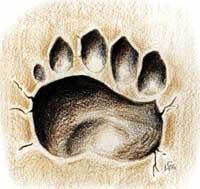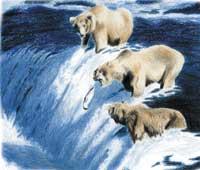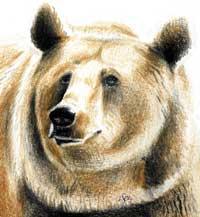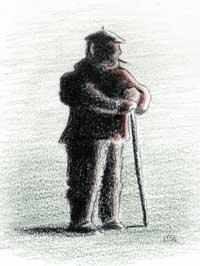The bear, every year less

The bear has been asleep throughout the winter. Good sleep, yes, but it wakes up in spring. And that awakening is not joking, it has awakened hunger, very hunger. He has left the ferment to look for food, burning energy throughout the winter has become very thin and still needs to recover his weight. So in the valley, the shepherds are worried. “Please don’t approach my flock,” most people think.
The bear wakes up around the carnival. No coincidence, carnivals have to do with the end of winter. Spring has not yet begun, but by then the toughest snowfall seems to be over. They know it in the Pyrenees of Navarre, as in the Baztan. How not? The millennial experience leaves a profound mark on popular knowledge.
In fact, in the traditional carnivals that have lasted in some of their villages reference is made to the bear; among the characters that go out to dance there is always a bear or some that in its origin was a bear. The importance of this animal for the human being is evident, not only in carnival dances, but also in the shields and other symbols of many peoples. Fascination or trembling? What does this mean? Both maybe.
The fascination with the bear is not surprising, it is not simply a beast. It is a big, dangerous animal, even hunter, but not disgusting. For those who see berries eating in the forest, it is a lovely animal. And not only adorable, but he has left man fascinated by his ability to stand on two legs. No matter what you do to threaten or spy on the environment: when you do, it looks like a strong, intelligent and fast human being. Of course, he walks on four legs, but in view of the footprints it seems that he walks on two legs, since he places the rear finger on the base of the previous one.
Well, sir bear

This mysterious animal disappears at the beginning of winter, gets into a cave and hibernates until the spring tempers. This peculiar way of coping with winter forces to recover energy when awakening. It is then that he begins to compete with man, when human fascination ends and he becomes frightened. The bear has to eat and one of the options is sheep or calves.
But he does not always eat cattle, but only when he has hunting facilities. Bear in mind that the bear is omnivorous, that is, in addition to eating meat, it also consumes fish and plants. The basis of their diet are plants, which account for 75% of the diet. Eat acorns, white hawthorn berries, beech acorns, chestnuts, blackberries, etc. Of course, he also likes honey very much.
When you eat meat, you do not always eat livestock or large animals; you also eat insects, rodents, trouts and other small animals. And besides what he hunts, the bear is a scavenger that feeds on dead animals. Therefore, in addition to livestock, the bear has a wide variety of possibilities to eat. So why does it kill cattle?
Itinerant
The bear can eat everything, but for this he has to live in a propitious environment. All these foods are available in a totally 'natural' ecosystem. Nature itself limits food. But today, in the lower part of the valleys, the bear does not find natural situations but of human origin, which means, on the one hand, that it does not find its natural resources and, on the other, that it meets the sources of food of the human being.

It should be in a natural environment to avoid attacks on livestock. But there is no space left. Cattle are found in valleys as well as forests and mountains. The bear finds sheep or cows easily and attacks them. If there is a solution, the bear is a habitable natural space, within which it can live. But there are many problems to have such spaces.
The first problem, of course, is getting the area, as cattle should get out of it. And despite having an area of these characteristics, you have to keep the bear, you can not afford to leave. And that is not easy either, since the bear is a great walker and that sooner or later will become famous for this space.
This itinerant character is well known by the Pyrenean shepherds, with few bears in the Pyrenees, so all are known. So sometimes, when they see someone, they identify him. Thus have biologists known that the bear moves quickly from one place to another; they have seen the same bear in places hundreds of kilometers away. Despite its apparent clumsiness, the bear has great mobility.
Due to this mobility, the area to be used for the conservation of the bear should have a very wide space, it is not easy to properly protect a large surface of this type. However, you can follow a pattern of different places: bear conservation areas can be used as a tourist attraction. This is what they do in American parks and, to a lesser extent, in Asturias, for example. The Bear promotes tourism, with special emphasis on conservation by the administration.

Will we ever see the bear of the Pyrenees? If the situation doesn't change much, no. In fact, the actions carried out to date in favor of the bear have not been seen with good eyes and, in addition, they have not been managed properly, so they have not been very successful.
The bear has a black future in the Pyrenees. In fact, in Euskal Herria there is only one bear (the famous Camille), and although there were ten, the chances of survival would be scarce. If not, the bear cannot be kept. And we lose our friend from the forest we have always had with us.
Can the bear be kept in the Pyrenees?
XXI. The conservation of the brown bear in the Pyrenees in the 18th century is not impossible, but rather difficult. To be bears it is necessary to protect your place of residence, which entails a long rope, since this species that needs large and quiet spaces faces a human development that constantly changes the environment. Therefore, in order for bears to live, all Pyrenean human activities, such as tourism, hunting, forestry or livestock, should be organized to be compatible with conservation.

Achieving this is not an easy task, but it is possible if we all put the will. The Pyrenees can be quite large to carry out skiing, wild boar hunting, grazing, or conservation of native species, but, of course, all must be done at the right time and place, that is, well organized. How? In the case of livestock, for example, you have to pay the losses for the bear and grant aids that guarantee the continuity of the activity by having to work in the place where the bear is. An adequate compensation and compensation system can largely solve the problem of animal attacks. The same should be done for forestry and hunting. That is, we should seek the compatibility of these activities with the bear and, if impossibility, compensate those affected. This would not be a major economic cost, and society should allocate money to it if it decided to keep bears.
In 1998 it was estimated that each of the bears of the Cantabrian Cordillera cost the administration 600 euros a year. In the Pyrenees, and taking as an example Camille, the cost is higher, but, however, it is an account of a few thousand euros that, in addition, with the implementation of systems of prevention of attacks, would be much lower. However, some would think that saving bears is too expensive. But look! If protecting the environment makes the bear live, then we would be conserving many other species, such as the bearded vulture, the woodpecker, the pyrenean frog, the liver pito, etc., the pyrenean ecosystem. And I believe that man too. And if we learned to live with bears and respond to their needs, we would be using the limited resources of the Pyrenees sustainably, so man would not be endangering the future of the world.
Miguel Mari Elosegi
Playing with energy to save lifeWhat can an animal do to protect itself from winter cold? The deer can do what it does: as the atmosphere cools, the valley can descend in search of a warmer place. But the bear does not, it hibernates. To do this, it is introduced into a bear and immersed in a slower state than sleep, transporting the body to the minimum necessary to survive, slowing the metabolism, breathing more slowly, pumping the blood at a rate of eight/ten beats per minute, does not eat and, of course, does not expel excrement or urine. Thus, it does not seem to imply an important energy expenditure, but it must be taken into account that it has to spend about four months in the ferment. And it is that hibernate is to play a dangerous game of energy. The fat man is introduced into the ferment, from which he comes out very thin, ready to recover the weight. But the problem doesn't end there. Bear in mind that the offspring are born during hibernation, which is an additional expense for the female. That is why they are born so small that they need the least energy during their stay in the ferment. However, it is surprising: an animal that will weigh more than a hundred kilos is born with 300 grams. The young leave the ferment in April or May, weighing five or six kilos. Of course, the mother fed them. It has had to fatten and feed its young; spring is a critical season for the bear. |





